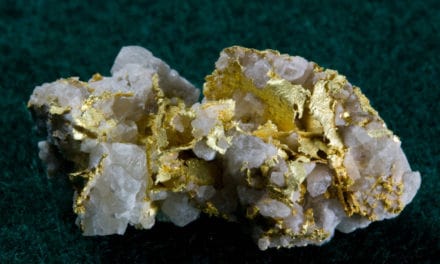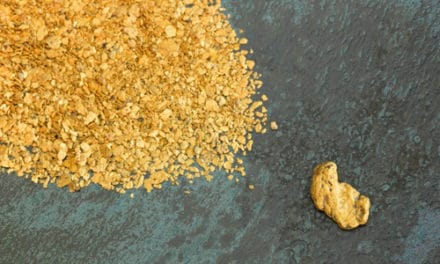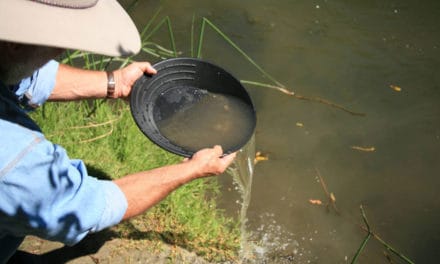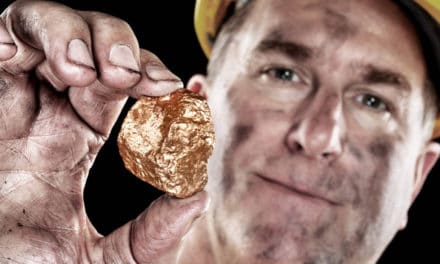By Charles Watson
[media-credit name=”Advanced Geologic” align=”alignleft” width=”300″] [/media-credit]GOLD! The elusive yellow metal has been sought after for thousands of years, been the cause of wars and pillaging, and is a symbol of affection when given to a love one. It is precious, it is valuable and it is very, very pretty. The history of gold is riddled with tall tales, folk lore, and exaggerations that would make the less inclined scoff and say “bah humbug! There’s no more gold out there!” But knowledgeable miners and prospectors of today are still finding gold in them thar hills, and many are becoming pretty darn rich – and having fun doing it!
[/media-credit]GOLD! The elusive yellow metal has been sought after for thousands of years, been the cause of wars and pillaging, and is a symbol of affection when given to a love one. It is precious, it is valuable and it is very, very pretty. The history of gold is riddled with tall tales, folk lore, and exaggerations that would make the less inclined scoff and say “bah humbug! There’s no more gold out there!” But knowledgeable miners and prospectors of today are still finding gold in them thar hills, and many are becoming pretty darn rich – and having fun doing it!
Between 1833 and 1918 the price of gold was fixed at around $18.93 per ounce. Economic winds changed and the price slowly began to rise. In 1934, the U.S. Congress passed the Gold Reserve Act, which among other things, fixed the price of gold at $35 per ounce.
In 1971, President Nixon took the U.S. dollar off the gold standard and the price steadily rose for the next ten years, peaking on January 21, 1981 at $850 per ounce! The run-up did not last, however, and after a few surges and declines, the price cratered and fell below $250 and ounce in June 1999. Now and after a 13 year-long run, the price of gold is now over $1,600 per ounce. It peaked on August 24, 2011 at $1,910 and despite all the economic pressures, has remained above the $1,500 and ounce for nearly a year.
Many economists forecast the price of gold to double or triple, or even rise much more, in the next few years, which is why people are trading in their briefcases, suits and ties for picks and shovels and pans. A record number of mining claims were filed in the last few years, recreational mining supply dealers can’t keep equipment on the shelves, and people are re-learning the historic art of making a living off the land by mining gold!
The Gold Rush is on!! Don’t get left behind!
So where do you go look? Where do you find it? Can you find it too? Oh sure! Some will do better, some not so good, but if you try and look in the right spot, get help from experts, and rub your good-luck charm just a tad, you will find gold too!
Remember your California history? One of the larges gold areas in the Golden State is called the Mother Lode Belt – a 400 mile-long, 75 mile wide swath of gold-bearing rocks and gravels in the foothills of the Sierra. Numerous old mining towns dot the trends with names like Seneca, Quincy, Downieville, Nevada City, Placerville, Angles Camp, and Sonora. Each have their own history, how the gold was discovered, where were the richer mines, who were the people that found their fortunes. For some, it is the history of those times that provides them with their wealth, while for others, it is and will always be the yellow metal. Both are compelling and each will change how you live your life.
Plumas County is the northern-most county in the Mother Lode Belt, and was one of the richest gold-bearing counties in California. The Plumas County Museum is a huge source of information of what happened in the county during the earlier gold rushes. Be sure to check out their exhibits too! The Plumas-Eureka State Park has wonderful displays as well. Find an expert, a geologist or miner, and learn from them. Research the internet for information, tips and techniques. You’ll find gold – there’s no doubt! There is still plenty of it out there.
Once you find your first speck, flake or nugget of gold, you will be hooked. It is fun for the whole family and who knows, maybe just maybe, if you are a bit lucky… you too will jump for joy, click your heels and shout “Eureka! I found it!”
Charles P. Watson is the chief geologist at Advanced Geologic Exploration located in Chester, California. He can be reached at cwatson@advancedgeologic.com












